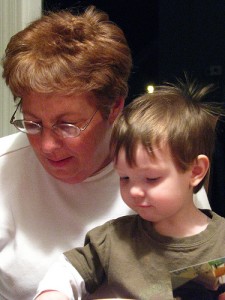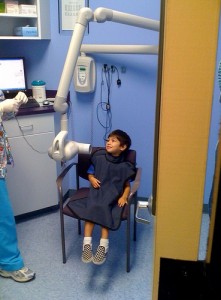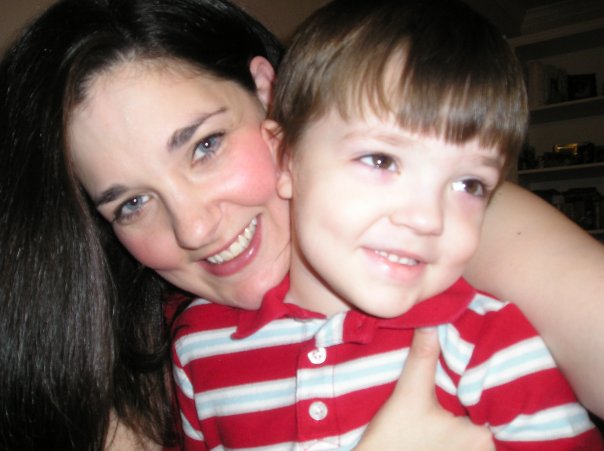Please welcome my friend and Guest Writer, Sharon, as she fills in for the traveling Amelia in the upcoming weeks. Sharon is an American currently living in the Middle East with her husband and two children.
 Most of us have been there. We arrive at Grandma and/or Grandpa’s house for a week long visit, only to find ourselves in a precarious situation. Why? Because your parents (or your spouse’s parents) are standing at the door, greeting your kids with one or more of the following:
Most of us have been there. We arrive at Grandma and/or Grandpa’s house for a week long visit, only to find ourselves in a precarious situation. Why? Because your parents (or your spouse’s parents) are standing at the door, greeting your kids with one or more of the following:
a) Large bags of candy
b) Several new toys
c) The latest “cool” techno-gadget
d) A week of planned excursions to expensive theme parks, malls, etc.
The week progresses, and every time you turn around, your child has a new toy or outfit. On one hand, you think, hey, it’s only for a week, then we get back to our normal lives. And this is true, to an extent. But what happens when this becomes habitual? Every time you visit them, or every time they visit you, the kids are lavishly spoiled by their grandparents. Or what happens when the kids start to demand things from Grandma or Grandpa? Ugh, no one wants to be in that position.
This has happened to us on a few occasions. We have the unique position of being parents to the only grandkids on either side of the family (hubby is an only child, I’m the oldest and, until recently, the only married one). In addition to that, our family lives overseas, so any opportunity the grandparents get to spend with the grandkids is rare and precious, and the presents can be a bit over-the-top at times. What do we do? Fear not, ladies! There are a few ways we, as moms, can handle out-of-control gift-giving.
For starters, we need to accept this fact: in general, grandparents WILL spoil their grandchildren. There’s really nothing we can do about it. Now, before anyone thinks I have a defeatist’s attitude toward this particular subject, I want to point out that I think that we CAN influence the AMOUNT of spoiling that occurs and make sure it doesn’t get out of hand. None of us wants to have kids that are ungrateful (especially to our own parents!), so it’s important that we approach it from two sides:
- Your kids – Remind them to say “please” and “thank you” when requesting or receiving something from your (or your spouse’s) parents. It’s really easy to teach kids manners when we are around teachers, friends, and even strangers, but the family arena seems to be the first place where politeness jumps out the window. Reminding kids about simple manners before they visit their grandparents can work wonders, and help your kids to remember to be thankful. If your concern is limiting the number of toys in the house, let the child(ren) know that, from now on, for each new toy they get from grandma or grandpa, they have to choose one of their older toys to give away to charity.
- The grandparents – This is the tough one, because some grandparents will react defensively, especially if approached in a confrontational manner. Start by thanking them for being so loving toward your children, and that their generosity is really appreciated by you. Then let them know you noticed how they much they like to buy things for your kids, and ask them if they’d be willing to redirect their giving. It doesn’t take much to “spoil” my kids (as they’re still fairly young), so if my mother, for instance, decided to give my kids a personal DVD player just for fun, I would consider that over-the-line. One way we avoid this in our household is by suggesting toys/games that our children would like to have, ones that seem a little more reasonable in price or quantity. That way, the kids get toys they want, and grandma and grandpa still get to have their fun. Ask them to save bigger presents for birthdays or Christmas. If you want to nip the toy-buying in the bud all together, suggest that your parents or in-laws come over with a little present, like a small candy bar or lollipop (or iTunes gift card for older kids), and they can put money in their savings account or college fund.
In the event where grandpa or grandma is not willing to change his/her behavior, there are a few options. The first one, limiting visits (especially for grandparents who live in the same town), is something I would call for in an extreme situation, where your concern is your child’s safety. Grandparents allowing young children to watch rated R movies after they’ve been asked not to, for example, would warrant a reaction like that. Most of us (hopefully) will not encounter this problem. Another approach is one I mentioned, having your children give away old toys for each new one that they receive. Or, get a bag of toys and take it over to grandma’s house the next time you visit. Let her know that the kids have too many toys at the house, and so you’re bringing some extras to stay at her house. After a few garbage bags full of toys, grandma and grandpa will get tired of the clutter, and probably get the hint.
So, have you ever encountered this problem? How did you handle it? What was your parents’ (or in-laws’) reactions?
Photo courtesy of garden beth
More about our Guest Writer: Sharon was born in Southern California, spent a bit of time in Hawaii, then moved to Texas for ten years, where she met her husband and had her first child. She now lives in the Middle East with her hubby and two kids, ages 5 and 2. Her favorite tea is Earl Grey, and favorite dessert is any cupcake from Sprinkles. She loves learning new languages (currently working on Arabic), traveling, and cooking.
 What ever happened to movies that are capable of portraying a valuable life lesson in a manner that is suitable for children? My husband and I recently took our two daughters (6 and 7) to watch Astroboy for what we thought would be a nice, entertaining evening – instead I spent almost the whole movie comforting my youngest and worrying about the nightmares they would have that night. I should have known things weren’t going to go well when within the first five minutes the little boy Toby (later referred to as Astroboy) is killed by a huge robot named the “Peacekeeper” (created by a government official to help him win his next term in office.)
What ever happened to movies that are capable of portraying a valuable life lesson in a manner that is suitable for children? My husband and I recently took our two daughters (6 and 7) to watch Astroboy for what we thought would be a nice, entertaining evening – instead I spent almost the whole movie comforting my youngest and worrying about the nightmares they would have that night. I should have known things weren’t going to go well when within the first five minutes the little boy Toby (later referred to as Astroboy) is killed by a huge robot named the “Peacekeeper” (created by a government official to help him win his next term in office.)





